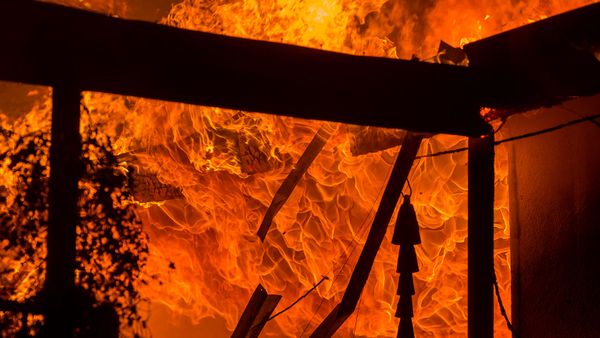
In August, the International Panel on Climate Change (IPCC) released its 6th report on climate change, and unsurprisingly, the news is dire. Responses to the report are calling on leaders and policymakers to quickly adopt measures to stem the tide and slow the temperature climb. With the environmental, economic, and political impacts of climate change being as serious as they are, the Department of Defense has listed climate change as a threat to national security.
According to the report’s recent analyses, the planet’s temperature has risen over 1.3°C degrees from pre-industrial levels with temperatures anticipated to increase by 1.5°Cby 2030, and by 2°Cby 2050. CO2 levels have reached 412 ppm and global emission levels aren’t coming down. If this course continues, global temperatures may hit as high as 4.4°C by the end of the century.
By this point, a large part of the planet will be unlivable.

Picture Source https://science.howstuffworks.com/nature/natural-disasters/siberia-2021-wildfires-news.htm
This recent Forbes article broke down the six most important take-aways from the report:
- There is no avoiding the fact that we will reach 1.5 °C. For the past few decades, the conversation around climate change has focused a lot of attention on reversing or stopping temperatures from rising. Change is difficult and there has been resistance in acknowledging what is happening. But as we are seeing, the rise we have already experienced has led to more wildfires, floods, and other extreme climate events. The higher the temperature goes, the more extreme these events will become. We can no longer talk about reversing this trend, the focus must be on slowing it or stopping it.
The report details five climate change scenarios based on how aggressively we pursue change, but in each one, we still reach this temperature. The reason we cannot avoid reaching 1.5 °C is that even if we stopped emissions today, all the emissions currently in the atmosphere would still push us there. Decades of pollution cannot be undone.
- The amount of “predicted uncertainty” over climate sensitivity has decreased. With any prediction or analytical model, there is an acknowledged gray area between what analysts are certain will happen and what they consider is less likely or unlikely to happen. That range has narrowed, and they are now more certain that these predictions will happen.
- “Major, very old climate science predictions — including the hockey stick and warming trends — were all correct.” As the quote accurately sums up, what scientists have said for decades would happen is happening, and will continue to unless things change—soon.
- “Extreme events — heat waves, droughts, floods, and even hurricanes — will all be more frequent and/or severe.” While 2020 went down in many people’s minds as one of the worst years in history due to the pandemic, 2021 has seen New York underwater, and wildfires get so out of control that Siberia—one of the coldest places on Earth, had more area burning than the rest of the world combined. This trend is predicted to get worse as decades go on as higher temperatures create a more unstable global climate system.
- “Sea level rise will be severe and long-lasting no matter what path we take.” When it comes to sea levels, we can’t put the ice back in the glaciers. With the melting of the polar ice, island nations and coastal cities are already feeling the effects of the rising tides. From Venice to Amsterdam to New York, major cities are built along waterways and coasts that will be underwater within years. Navigating these challenges will take creativity and ingenuity as the levels rise.
- “Achieving zero net CO2 emissions is mandatory, and the timescale is key.” One thing that both the article and the report state as a way of stopping this climb is achieving Net Zero CO2 emissions. The faster we achieve this target, the sooner we can halt what is on the horizon.
The Human Factor
The science is clear. 95% of the drastic increase in temperatures and emissions is due to industrial growth over the last 150 years. From fossil fuels, warfare, and deforestation, there is a lot of responsibility on our shoulders. Going forward these problems have to be addressed. As this Time article states “If we allow emissions to continue unchecked, temperatures are likely to rise more than 4.4°C by the end of the century—a level that would make life unlivable on vast areas of the planet.”
The flip side is there is a lot that we can do to correct this path.
Net Zero and Beyond
As businesses and individuals, we can put pressure on our governments to adopt better and more sustainable policies to prevent this future. There are also practices that we can embrace. One area that outdoor advertisers and businesses can embrace is the push to Net Zero. As mentioned above, the sooner we all adopt it, the better, but what is Net Zero?
When it comes to climate change strategies, there are many that we hear of in the media: carbon capture, carbon sequestration, carbon neutral, and net zero, to name a few.
Carbon Capture and Carbon Sequestration
Both carbon capture and sequestration involve pulling CO2 from the atmosphere and storing it elsewhere. These tend to be industrial-level strategies and so are beyond the scope of billboard advertisers and related industries. That leaves carbon neutral and Net Zero.
Carbon Neutral and Net Zero
Both terms have been used somewhat interchangeably but there is a great deal of difference between them. This Ecologi article breaks it down well. Carbon neutral involves “purchasing carbon reduction credits equivalent to emissions released, without the need for emissions reductions to have taken place.” Known as carbon offsets, these credits are often used by airliners and car rental facilities. Users can add these as to the cost of their journey to offset the environmental costs associated with them. These credits would be used to fund carbon reduction projects like green energy. With carbon neutral, emissions are still taking place.
Net Zero, on the other hand, is more ambitious. It focuses on “reducing emissions in line with latest climate science and balancing remaining residual emissions through carbon removal credits.” Carbon removal credits fund projects like carbon capture and removal from the atmosphere. They also fund reforesting the planet.

Picture Source https://cdn.theconversation.com/files/94013/width1356x668/image-20150907-22253-rnp0iv.jpg
One other major difference is instead of allowing emissions to still happen or do nothing about the pollution already in the atmosphere, Net Zero “requires all available technologies to be used to reduce baseline emissions.” Meaning that businesses and agencies are expected to account for all emissions generated along their supply chain and work to get those to zero, rather than just the ones they are directly responsible for. There is a lot more that is involved but what this does is build a long-term strategy and focuses on a holistic approach to business sustainability, rather than what critics call “green-washing”.
But to do this effectively, the time for adoption is now. In the UK, Bureau Veritas is encouraging businesses to embrace Net Zero ASAP, to “do their part” to help stabilize temperatures. The article linked above notes that already “three quarters (78%) of UK businesses have made a Net Zero pledge.” Those looking to follow these initiatives must do so strategically. Based on the article, these are the four steps that outdoor advertisers can use to achieve Net Zero:
- Bureau Veritas recommends that businesses start by calculating the day-to-day operational baseline carbon footprint of the company, and then evaluate the footprint of their supply chain. This is the first step along the Greenhouse Gas Protocol.
- Next, setting “interim science-based targets” for the next five years will keep creative outdoor advertisers on track with their net zero commitments. Making goals achievable means that they will be more successful in the long-term and outdoor advertisers accountable.
- Turn your mountain into pebbles. Commit to the easy carbon reduction strategies. Looking at energy consumption, reducing waste, and moving towards renewable energy sources. Using LED-lit digital billboards powered by wind or solar power adds up when you consider how many outdoor billboards there are in the world. Even working remotely and cutting down on employee commutes and travel can make a huge impact on carbon emissions. While the problem of climate change is global, thinking local and on the micro level does make a difference.
- Lastly, collaboration. Reach out to your customers, talk to suppliers, and work with regulators. There are opportunities out there, from climate reduction funding grants, alternative markets, and more. As an industry, OOH advertising is better positioned than others to achieve Net Zero. In the UK alone, all four major suppliers of OOH advertising implemented strategies towards carbon neutrality.
Advertising, Sustainably
Across the advertising industry, many agencies are doing their part to fight climate change, with much of the push to do so coming from within. In another article from the UK, the Advertising Association (AA) announced that they have launched Ad Net Zero, “an industry-wide initiative to help UK advertising respond to the climate crisis caused by CO2 emissions.” The goal is to achieve true Net Zero by 2030—twenty years sooner than targets set by some industrialized countries. As the article details, within the UK advertising world “71% people working across the industry are worried about the negative impacts of the industry on the environment.” Many within our industries care about what is happening and what we can do about it.
Beyond averting climate catastrophe, prioritizing these measures will also help outdoor advertisers in other ways, regardless of whether they are digital mobile billboards, truck wrap companies, traditional billboards, or digital billboard companies.
Consumer Accountability
More and more, we are facing pressure from consumers to adopt socially responsible behaviors, especially around climate change. And they want more than lip service. In a recent study done by BBC Global News, “81% agree that clearly demonstrating a commitment to sustainability adds value to a brand and 79% say sustainable practices and commitments are an important consideration when making purchase decisions.”
In a survey, Deloitte discovered that one in three consumers stopped purchasing products or brands due to “ethical or sustainability-related concerns.” The survey also determined that consumers valued five environmentally sustainable or ethical practices equally, those practices being: Waste reduction, reducing carbon footprint, producing sustainable packaging, committing to ethical working, and respect of human rights. Not adopting these practices could cost outdoor advertisers more than it would to implement them.
Making the Choice Before the Choice is Made for Us
Nations are facing increased pressure to address climate changes issues. With several major international conferences on the climate crisis on the near horizon, it will only be a matter of time before climate recommendations become national policies and regulations. One such conference to watch is COP26, the U.N. climate conference in November.
Adopting measures before the government dictates them means that outdoor advertisers will have the opportunity to influence upcoming regulations. Once we get beyond the voluntary adoption stage, the ability for businesses to have their inputs on these issues will be reduced. Early adopters of Net Zero and other climate change policies will have far more influence on how regulatory conversations are shaped versus late-stage adopters.
The Last Word
The news on climate change is not great. In fact, it is downright frightening. Between the widespread, increasingly frequent, and increasingly intense, extreme weather events, rising sea levels, and the very real concern of ecological collapse, the need for immediate change is here. At all levels of society from political, commercial, and personal, we all must work together to change the course we have set. We need to prioritize transformational change at all levels.
While there is much to be concerned about and even more to be done, there is hope at the end of this. One final note from the IPCC Report states that if we can achieve this, we will see temperatures peak but then go down, finally stabilizing at a point where life can thrive. As Inger Andersen, the head of the United Nations Environment Programme, says, “We can’t undo the mistakes of the past…But this generation of political and business leaders, this generation, conscious citizens can make things right.”
It’s on all of us but it can be done.


